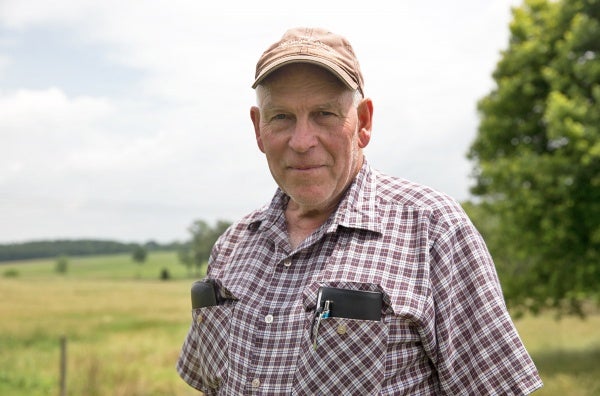With modern amenities and allegiance to history, Battle of Gettysburg again sprawls across Pa. fields
“Our staff calls it ‘The Juice’,” said Randy Phiel of the Gettysburg Anniversary Committee, while driving his SUV across the farmland that will become the Battle of Gettysburg.
“All the community is out here, obviously they’re making some extra money. But The Juice is something unique, something different, something diverse, something you normally don’t experience,” he said.
Phiel and his partners have been staging the Battle of Gettysburg, in Gettysburg, for 18 years. It’s one of the largest and oldest Civil War re-enactment events. This year, on the 150th anniversary of the battle, an estimated 100,000 people — re-enactors and spectators — are expected to come to this field over the four-day event.
But don’t call it the Woodstock for Civil War buffs.
“That statement makes me quiver a little bit,” said Phiel, chairman of the Adams County Board of Commissioners. “When it comes to historical integrity, I’m not sure Woodstock is a good equation. But as far as marking a milestone in our nation’s history, I’ll go along with that.”
Much of what Phiel and his organization has been doing for the last six months is making sure the event does not go the way of the famously flooded music festival.
“That’s our command center,” said Phiel, pointing to a farm shed behind some trees. “The back third looks like a 911 center. We have three dispatchers, 20 radios, we’re hooked into the state police. We have three 24/7 EMS stations. We have 300 (portable) johns. Two trucks will continuously clean (the) johns. We have two trash crews.”
This Battle of Gettysburg is better equipped than the two armies that stumbled onto one another near Gettysburg in 1863, sparking a fierce fight that lasted three days, eventually turning the tide of the Civil War in the North’s favor.
Approximating the famous battle sites
The actual locations of the original fighting — the Peach Orchard, the Wheat Field, Cemetery Ridge, Little Round Top, etc. — are parts of a protected national park. No battle-re-enactments are allowed. Phiel has rented two tracts of farmland opposite Table Top Road, just north of Gettysburg, to represent nine different battle sites.
The trick is to make this one piece of real estate resemble nine different battle sites. The organizers built a low stone wall in a hayfield to represent The Angle on Cemetery Ridge, a low rise in the topography can represent Culp’s Hill, and a small creek will be used for Willoughby’s Run.
The farmer who owns the property, C. David Redding, has allowed a patch of unreaped hay to grow tall. “They would like a nice bit a acreage for the Wheat Fields,” said Redding. “It won’t be wheat, but it will look like wheat. It will work appropriately.”
With a little bit of rearranging, some imagination, and 10,000 costumed re-enactors — including infantry, 400 cavalry, and artillery with 40 cannon — will transform the hay field into several bloody war zones.
“Some of the dramatic moments will be for the spectators and re-enactors,” said Brian Gesuero, a firefighter from Baltimore who has been planning the logistics of the fighting for six months. “For Culp’s Hill, there is a big swale of ground there. As the Union is in the woodline, they will not see the Confederate until the last 10 yards. The whole division will come up over the hill and be on their front.”
A major component of the re-enactment is the living history sections, where sutlers will offer demonstrations and merchandise of the historical era. Part of the non-combative events include a historically accurate and legally binding Civil War wedding and a battle of the Civil War bands, Coronets and Cannons.
By the time all the battles have been lost and won, every square foot of Redding’s 375-acre hay farm will have been trampled over by 100,000 visitors. The land will be rested for the remainder of the growing season.
‘A city comes, and a city goes’
“After it’s over, the major project is cleanup,” said Redding, whose family has owned the property since 1949. “A city comes, and a city goes. The cleanup can be quite involved.”
As it is, so it was. During Pickett’s Charge on Cemetery Ridge — the South’s last, desperate push in Gettysburg — the Philadelphia Brigade kept its band nearby. The musicians stood alongside the soldiers, playing “The Star Spangled Banner” over and over to boost troop morale. When the fighting was over, the same musicians tended to the wounded and the dead.
“They had a lot of people buried where they fell,” said Robert Philbin, the conductor of the Philadelphia Brigade Band, a Glassboro, N.J.-based outfit which re-creates the original ensemble. “They tried to get everybody’s name on a piece of wood or a cracker box, before everybody left and nobody knew who was who.”
Philbin will be leading the band in Gettysburg this year to fight against other bands — with coronets instead of bayonets.
WHYY is your source for fact-based, in-depth journalism and information. As a nonprofit organization, we rely on financial support from readers like you. Please give today.










